Four Keys: Jay Banner Finds Balance in Teaching and Research
November 8, 2013
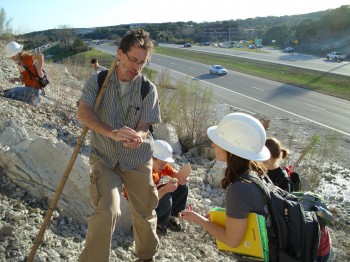
When Jay Banner accepted his first faculty position, teaching was just something he had to do so he could do what he really loved—research. In particular, studying the processes by which ocean sediments become rock, tracing underground flow paths of water and using cave formations to reconstruct past climate. His first teaching assignment was an undergraduate course in sedimentary geology.
“I somehow felt compelled in those 15 weeks to teach them everything I had learned in 16 years [of post-secondary education],” says Banner, professor in the Jackson School of Geosciences and director of the university’s Environmental Science Institute. “That works out to about four months per lecture. So I was talking non-stop at too high a level, about too much stuff.”
His students got the last word, though, when it came time for evaluations. One comment has stuck with him through all those years: “Banner should be giving these lectures to the other faculty.”
He took those harsh evaluations as a challenge. When attending seminars and lectures at the university and at professional conferences, he now found himself not just listening to the scientific results but also considering what made a speaker effective or not. Building on this insight for his next course, he put a more focused effort into planning each lesson. Eventually he realized he actually liked teaching.
He had discovered one of four keys to great teaching, which he sums up with the mantra “less is more.” Instead of trying to fill students up with facts, help them develop critical thinking and problem solving skills. Those fundamental skills will last much longer than mere facts as they go on to work in the real world.
“Each semester I throttle back a little more,” he says. “I think I’m finally getting there.”
He recently received three of the university’s highest teaching awards: a Board of Regents’ Outstanding Teaching Award (2013), a Friar’s Centennial Teaching Fellowship (2011) and membership in the university’s Academy of Distinguished Teachers (2011). He’s also won the Knebel Distinguished Teaching Award from the Department of Geological Sciences (three times) and the Outstanding Educator Award from the Jackson School of Geosciences.
Second Key: Get Them Out in the Field
As an undergraduate at the University of Pennsylvania, Jay Banner first majored in chemistry. But then after a couple of years, unable to see the applications of chemistry to real life problems, he switched to geology.
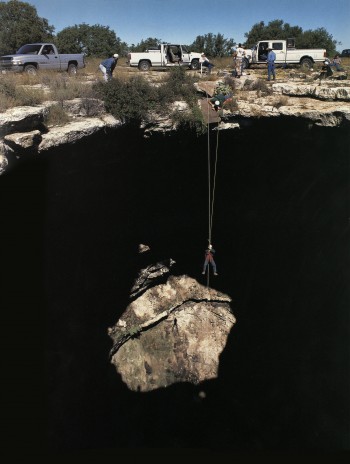
Near the end of his bachelor’s, he had to take a capstone field course designed to integrate what he’d learned throughout his degree and reinforce all those facts and textbook illustrations with concrete, so-that’s-what-it-looks-like examples. His university didn’t offer a capstone field course, so he headed to West Texas to join the group at Sul Ross State University. It was his first time west of the Mississippi and his first time in the desert.
The class would set out from the Sul Ross campus on trips to Big Bend National Park and other parts of Trans-Pecos Texas. One day, he came up over a hill and saw an igneous ring dike, a wall of magmatic rock standing above the surrounding land due to its resistance to erosion.
“I thought Holy Cow, it was a textbook just jumping to life,” he says.
He kept having these light bulb moments.
“Up until then, I wasn’t convinced about my decision to switch to geology,” he says. “After a couple of weeks, I had an epiphany. Oh yes, this is what I was meant to do.”
Not only did it confirm his choice of major, it taught him the second key to great teaching: get students out in the field. By getting out of the classroom and engaging all their senses, students absorb the concepts more vividly and, if they’re lucky, find their passion.
Many years later, Banner chaired the committee that drew up UT Austin’s first degree plan for a B.S. in environmental science, which was approved in 2010. As part of the core requirements for that degree, he designed and now teaches an environmental field course taken in the second semester of college, not a capstone course taken at the end of the degree.
“The idea is that if you get students as jazzed as I was on my field course, but do it early in their career, it might serve them better so that when they’re suffering through math and chemistry and physics, they’ll understand why,” he says. “They’ll see the value of having those quantitative skills and the fundamental technological know-how.”
Time Machines
For his PhD, Banner used isotopic tracer techniques to study how ancient marine sediments are transformed—from the time they are deposited as sediments, become buried, interact with fluids flowing through them and eventually become carbonate rocks—a process known as diagenesis. He focused on Mississippian-age marine limestones deposited by an ancient interior ocean in present-day Iowa, Illinois and Missouri approximately 350 million years ago.
Later, as a professor, he and master’s student MaryLynn Musgrove, now a hydrologist with the US Geological Survey, were surprised to discover that, based on isotopic analyses, water discharging from springs in Missouri had originated over a thousand kilometers away in the Front Range of Colorado. They also helped solve a long standing mystery about why groundwater in that part of Missouri was nearly as salty as seawater.
Before coming to Austin to join the faculty in the Department of Geological Sciences, Banner spent part of his time as a post-doctoral researcher studying groundwater chemistry in a popular tourist cave in Barbados. His work was aimed at helping islanders better understand how their groundwater system worked, a system which provided the growing nation’s only source of freshwater.
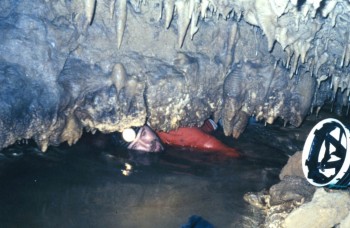
One day he was squatting in a low-ceilinged room in the cave collecting water dripping from the ceiling, being very careful not to bump into a stalagmite right behind him. Stalagmites, you’ll remember, are rocky towers that form on the floors of caves, growing upward as water dripping from above deposits microscopic layers of minerals. He stared at the stalagmite and wondered, could this formation tell me something about past climate?
He suspected strontium isotopes might hold the key. He knew, for example, that the limestone rocks containing the caves had a different strontium isotope signature than the soils above and that rainwater usually has essentially no strontium. Just like your clothes when you walk through a room full of cigar smokers or a chocolate factory, water moving through the soil and limestone should pick up a whiff of the places it’s been. Banner reasoned that during rainy periods, water moves quickly through the system and doesn’t have time to get an imprint from the limestone, whereas during periods of low rainfall, water has time to pick up the limestone strontium signature.
He and his colleagues studied several Barbados speleothems, a catchall term for stalagmites and other cave formations. From their new way to apply strontium isotopes (limestone signature = dry; soil signature = wet), they interpreted changes in strontium isotope ratios as changes in wetness over time going back 5,500 years. It was the first time the technique was applied to speleothems.
They identified an extremely dry period about 1,200 years ago which coincided with other evidence of a major drought in the Mesoamerican tropics and which some experts have linked to the collapse of Mayan civilization.
“This is what got me started looking at speleothems and I’ve never looked back,” he says.
An Eye on Texas Droughts
Since coming to Austin in 1990, Banner has extended his research with speleothems, and also with tree rings, to address one of the biggest concerns on the minds of Texans—drought. The state is still in the grips of a drought that began in fall 2010. The state experienced its worst single-year drought in 2011. Agricultural losses in that year alone were more than $7 billion. Rather than see their herds starve, cattlemen sold off their stock in record numbers. The water supply to rice farmers on the lower Colorado River was entirely cut off to save water for cities such as Austin
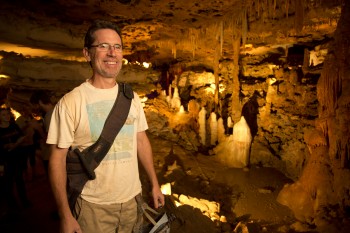
Banner warns it could get a lot worse
He and his colleagues used tree rings to reconstruct the history of Texas droughts for the past five centuries. Their study, in combination with others, found a number of droughts longer and more severe than the six-year 1950s drought, the worst multi-year drought in the historical record. Some droughts in the pre-historic tree-ring record lasted 20 or 30 years. Since the 1500s, droughts lasting a decade or more have occurred in Texas at least once a century. As if that weren’t ominous enough, some climate models predict more frequent and severe droughts in Texas during the coming century
At Westcave, a small cave about an hour from Austin, Banner and his colleagues are now trying to understand what triggers droughts and what turns an ordinary drought into a record-busting mega-drought
Thanks to thick insulating rock walls and small openings to the surface, the air inside most Texas caves hovers around the same temperature year round. It’s what makes them so refreshing on a hot summer day, but not very useful for gauging past temperatures. Fortunately, Westcave isn’t like most caves. Because it’s small and has big, wide open entrances, the temperature inside is always about the same as the temperature outside. That makes it one of the few caves in Texas where speleothems could possibly record real outside air temperatures
Working with Banner, graduate student Richard Casteel, postdoctoral fellow Weimin Feng, and undergraduate student Ayla Heinz Frye have shown—using natural and experimentally-grown speleothems in the cave—that oxygen isotope measurements in speleothems from Westcave indeed record changes in air temperature over the past decade. Now, their objectives include going back thousands of years with high enough resolution to see not just individual years, but changes from season to season, and to combine such a temperature record with drought records from tree rings to better understand whether severe droughts are driven more by heat or lack of rainfall.
(To see a video about the Westcave research, go to http://youtu.be/NFzMidB35C8)
Hot Science
As a professor, Banner has managed to strike a balance between teaching and research without sacrificing either. As director of the university’s Environmental Science Institute (ESI), he’s also been at the forefront of public outreach at the university.
In 1999, he began organizing a series of public lectures that have become the most highly visible and successful of the institute’s projects. The Hot Science – Cool Talks series invites K-12 teachers, their students and the general public to hear from scientists doing groundbreaking research.
Hot Science talks typically draw more than 400 people—occasionally reaching overflow crowds of 600 or more—an impressive turnout given that they’re usually held on a Friday evening. The talks, held six times a year, are also webcast live for those who can’t attend in person. Teachers receive free classroom materials that enable them to give their own lessons on the featured topic. So far, 83 events have been held and more are in the works. Talks scheduled for this fall include “Human Mating Strategies,” “The Roving Search for Life on Mars,” and “Now You See Me, Now You Don’t: Colorful Strategies for Surviving in Nature.”
Through the ESI, Banner is also the principal investigator for a National Science Foundation-funded project called Research Experience for Undergraduates (REU) in The Science of Global Change and Sustainability. The program brings about 10 students to UT Austin every summer and pairs them with faculty mentors such as Banner to work on 10-week research projects. Many of the students, such as Heinz Frye, come from smaller universities with few research opportunities and facilities.
Summer REU research projects address major societal challenges such as climate change, loss of biodiversity, and threats to water resources and food supplies. Students learn how to do research, design their own short research project and present their results in an end-of-summer student symposium.
Banner notes that fewer and fewer students are choosing careers in science, engineering and math, a trend that does not bode well for the future of a country long seen as innovative in science and technology.
“If you can get students involved in research, they get excited about it and more of them choose to go into it,” he says.
That’s why he says a third key to great teaching is to give students a chance to do real research.
Fourth Key: Get Their Attention
So, class, let’s review what we’ve learned so far about great teaching: keep it simple, get them out in the field and give them research experience. Last but not least, Banner says a fourth key is to make it vivid.
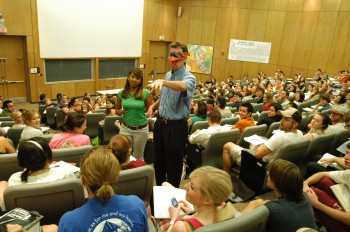
“When you’re looking out at 240 faces, if all you’re doing is standing still next to the PowerPoint and clicking through, eventually those faces are going to fade,” he says. “They’re not going to continue to pay attention.”
You can see many of his strategies for making teaching more vivid if you drop by Sustaining a Planet, an interdisciplinary class he created with engineering professor David Allen in 2006. He continues to co-teach the class every year.
Banner enhances his presentations with videos, animations, and pop music, all designed to help reinforce concepts presented in a given lecture. He invites a student to run across the room and throw a football to demonstrate the Coriolis Effect. He models atmospheric circulation by heating a laundry bag full of air and letting it rise to the ceiling of a large lecture hall. He shows students clips of a psychic on the TV show Crossing Over and then demonstrates his own psychic ability to randomly pick students out of the lecture hall and reveal their relationships to bodies of water.
“I challenge them to use the scientific method to prove that either I have special abilities or I’m full of it,” he says.
Sustaining a Planet was the first of the university’s signature courses, interdisciplinary classes taught by the most engaging faculty and part of every student’s core requirements. Many of the students do not have a background, or even an expressed interest in, science and the environment. While Banner’s primary goal is to help students develop the ability to think critically about scientific concepts, it’s just as important to him that he gets them fired up about science. He admits he’s come a long way since that very first class in 1990, when he wanted to teach students everything he knew.
“I think what makes a good teacher is that you share with your students your excitement of scientific discovery, what gets you jazzed about science,” he says. “If I can impart some of that to students, then I think I’m doing a good job as a teacher.”
– Marc Airhart
